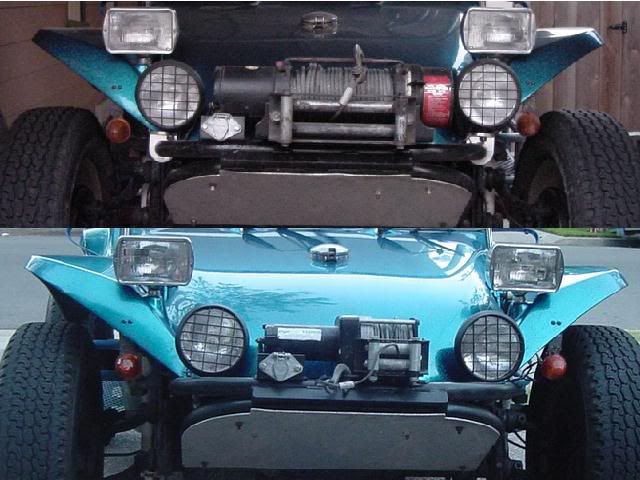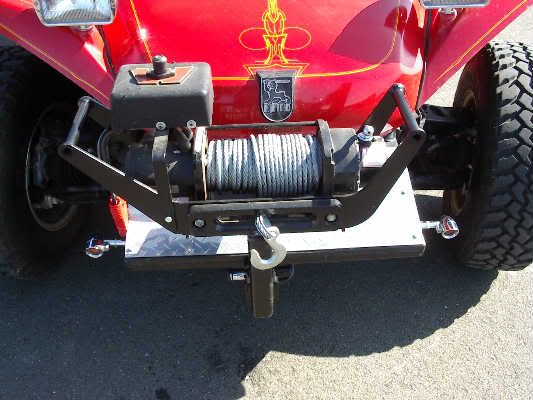A Tech Article by
Gene Condon
The first consideration you need to ask your self is;
Why would you need or want a winch on your buggy?
What kind of off road driving do you do?
What are your needs?
What is your skill level?
PICKING THE WINCH
Once youve determined whats and whys go get your buggy weighed. Weigh your buggy with all the typical gear and essentials that you typically take. Yes, ice chest too! This will give you a true understanding of your buggy. The rule of thumb for picking the minimum size winch for your buggy is to get one with a rating of double the weight of your vehicle. Winches come in different strengths, qualities and sizes so do your homework. Pick a winch that fits your needs as well as you budget and most of all fits in your buggy.
THE WINCH
ATV winches range from 1000 to about 3000 lbs. The cable diameter on ATV winches varies from 3/16-1/4 and the cable length ranges from 25-60 feet. They weigh between 20-25lbs they are small and will fit almost any where on your frame or with in your front bumper. I recommend these with all kind of flat work off road driving. Flat work is the term I use for sand, moon dust or mud and where a short pull is all thats needed to get out of most situations. These winches will work fairly well for use to pull your buggy out of most flat work situations. However, on almost all these uses the winch was at its load limit each time. I used a pulley to compensate for the winch load limit to give me that 2-1 advantage but in doing that I lost half of my cable length. The loss of the cable length was not an issue due to the flat terrain and only having to do short pulls.

Since most buggies average approximately 1300-1600 lbs, a 3000lb winch would be the minimum size winch to use. I ran a 3000 lb winch with a pulley for years on Gadget and it got me almost out all of my flat work situations. A 2500 lb and smaller winch are just too small for buggies and should remain on ATVs only.
Self recovery and portable winches are the next step up in size for winches. They range from 5000-15000 lb strength with the cable diameters that range between 5/16-7/16. The cable lengths range from 80-150 and the units weigh between 50-100 lbs. 5000 -8000 lb seem to be the right size and power on a buggy. The weight is a bit more which could be an asset if your one of those trying to keep the buggy front end down. These types of winches will work very well with all off road applications for buggies. If you are planning to get in to the rocks, canyons and steeper climbs these are the units that can get you or your friends a big helping hand. These pulls, unlike the flat work will be long and tiring. You will be able to run these winch cables full length and not have to use a pulley in most situations. The bigger cable diameter and length combined with the power is a must in the mountain/rock situations. You will use every bit of cable and be asking for more.
When I upgraded from a 3000lb to the 8000 lb winch I have now. I spent a lot of time trying to visualize the bigger winch on Gadget; wondering if would look too out of place.
Once I took off the old winch and set on the new one and stand back did I say oh yeah

MOUNTING THE WINCH
You have a few choices of placement depending on the size winch you have chosen. First find a good mounting spot, this is done by finding the right type of bumper that will have enough space to fit either with in or on top of the bumper You will then need to either buy and modify the MFGs mounting plate to fit or weld in a inch plate to the spot of your choosing to mount the winch. I like the factory mounting plates because it they have all the mounting holes for the fairlead and winch already and all you have to work on is placement. You will then need to run a couple of support bars from the back of the plate back to the frame.

The other option is to make the winch removable so that you have the option of when and where you want to mount your winch.
Ken T mounted his so that he can on the front with his receiver system. This system you can mount front or rear on the road so you dont have to turn your buggy around in some situations.


Once your winch is mounted you will now need to work on the battery. When running an ATV winch (>3000 lb ) a good single battery should be fine since most of the pulls will be short and un-sustained, whereas the larger recovery winches can be long sustained pulls, a small back up battery with a selector switch is not a bad idea. On one of our recent trips I had to make sure the engine did not stall while doing a long pull otherwise a jump was required. This could have been a bigger problem than it was had it not been for
the other buggies on the trip. Make sure your cables from your winch to the battery are large enough to handle the draw. Since the buggy battery is in the rear and the winch is in the front you can have 6-8 ft of cable run. The last and final part of the installation is to make sure you have sufficient locations in the front and rear of your buggy so that you may attach tow straps. You will need these to anchor to trees, other buggies or your pulley. Most buggies do not have a rear cage or front bumper, so even if you are not going to mount a winch , have some areas available so a winch or tow strap can be attached in case your buggy gets stuck.
THINGS TO CARRY
Tow strap - One is minimum 2 would be nice. Youll need these as anchor straps to other buggies or to extend your winch length reach.
Gloves - a must when handling cable.
Pulley - doubles your winch strength and also be tied to an anchor to direct your cable angle.
First Aid Kit.